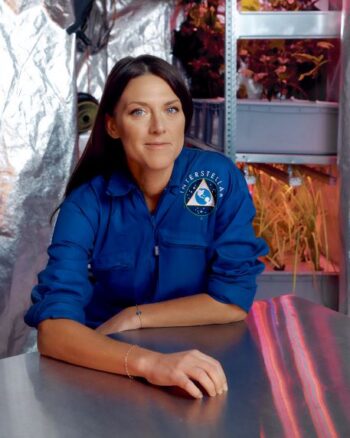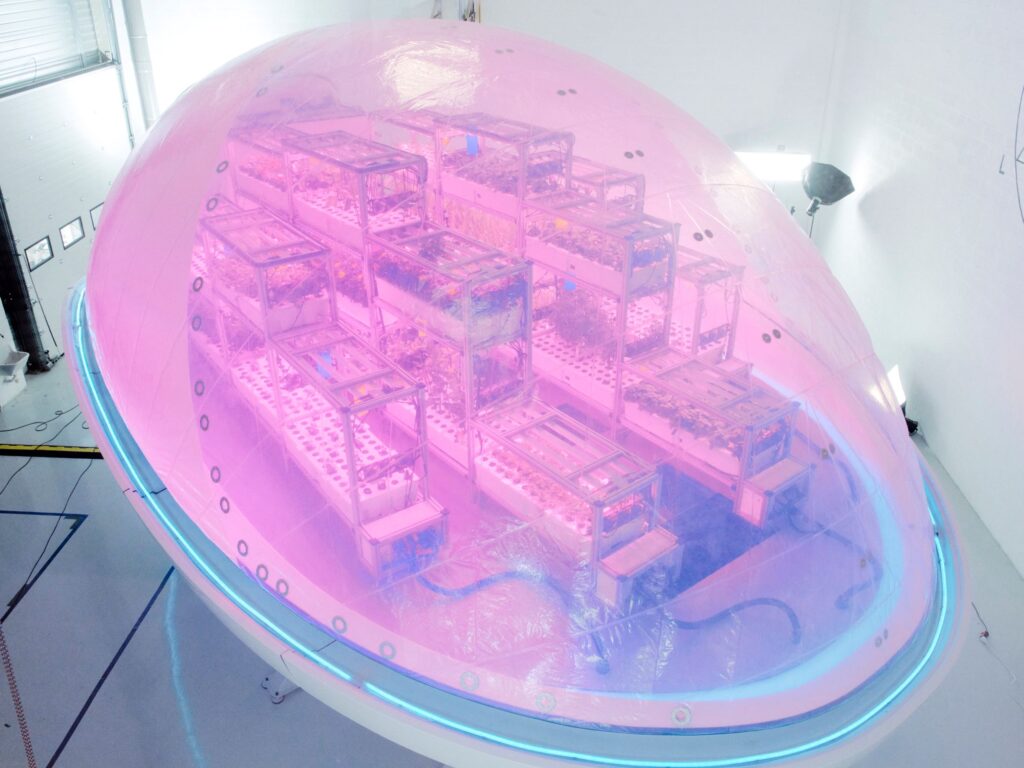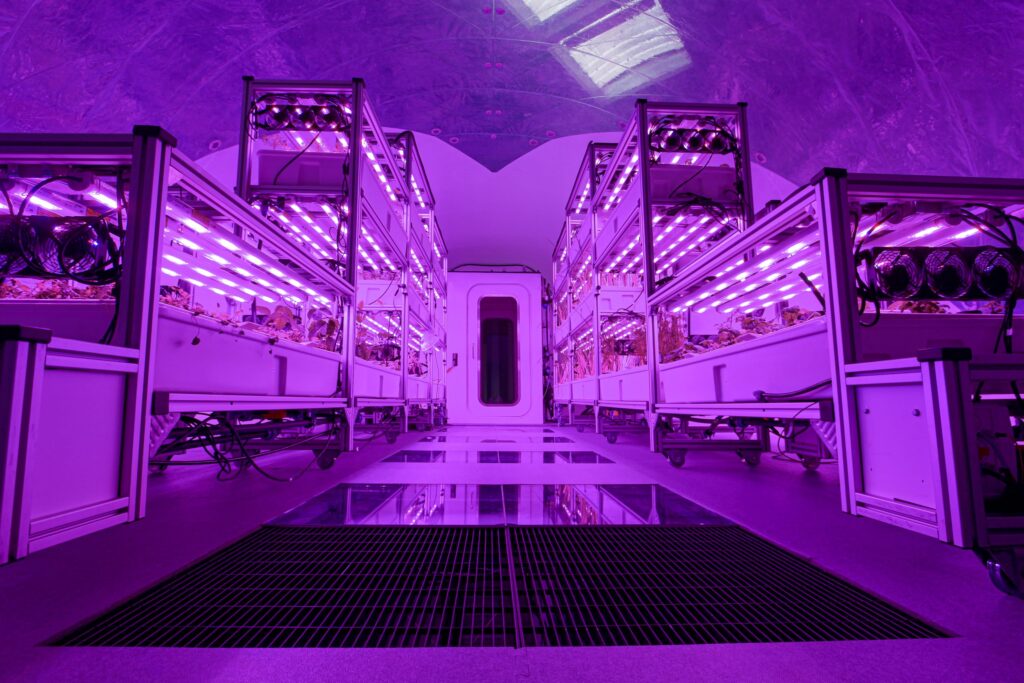How many of us can truly say we’ve followed our dreams? Let alone one as fantastic as living on Mars.
Growing up, Barbara Belvisi would say she was a bit of a nerd. Feeling lonely after skipping ahead a class in primary school, she’d find herself dreaming of somehow, someway, leaving the place where she lived.
“As a child, I was fascinated with becoming a multi-planetary species,” Belvisi says. “I was a huge fan of the Earth, biodiversity and studying plants and animals. I’d dream of building domes on another planet, so I could live with my imaginary friends, with various flowers and animals.”
Fast-forward a few years, and Belvisi found herself working in finance. She was helping entrepreneurs start companies and raise capital. But she became disenchanted with it, realizing that nothing she was funding was addressing problems around food production or preserving biodiversity. The dream from childhood was resurfacing.

“So I started imaging a structure where we can, at the same time, grow food and recycle the water and recycle the waste in a closed loop environment and I trained myself to start building it,” said Belvisi. “It led me to this idea of: What if the system that we would use in space could help us on Earth right now? It’s like everything I have done in my life was leading me to this.”
After spending a year with NASA engineers, Belvisi launched Interstellar Lab with the goal of developing food production and habitation modules for sustainable living on Earth and in space.
In June 2022, Interstellar started the assembly of its first BioPod, an advanced indoor farm conceived as a controlled-environment module that would enable plant growth in any environment on Earth The autonomous greenhouse can grow more than 300 species and produce up to five tons of food per year. A vital step toward a future lunar version, the first BioPod was unveiled to the public in September 2022.
Belvisi spoke to Dassault Systèmes about a wide range of topics – from Interstellar’s mission to what she’s reading to, of course, “What’s for dinner on Mars?”
3DS: Tell me a little bit about Interstellar – what do you do, and why do you do it?
Barbara Belvisi: At Interstellar, we specialize in designing and building deployable structures in which we control all the climate conditions, all the environment. Temperature, humidity, light, atmosphere. And we recreate a microclimate inside, allowing plants to grow and life to thrive. The general idea is to be able to do that on Earth and also in space. If you think about it, we’re combining structural design, hardware design, and also software and database. The software part is all the intelligence that is running our system. And then the database is the catalog of plant recipes. We give anyone the tools, so they can grow any plant they want under any environmental constraints.
3DS: How do you describe the Big Problem you’re going after, that Interstellar is trying to solve as a company?
BB: On Earth, we’re providing a solution for food production and biodiversity conservation. We’re developing a solution that allows plant cultivation in a much more sustainable way – using less water, less energy, and not harming the soil. It has many applications, but the two main ones are food production and biodiversity conservation. In space, it’s also food production – growing food to feed astronauts – and also biodiversity conservation. How can we bring life to other planets? Those are the main drivers of what we do at Interstellar.

3DS: Becoming a multi-planet species. It’s something you’ve believed in and dreamt about for a very long time. What’s it going to take to get there? And how close is your dream to becoming reality?
BB: In less than five years, humans are going to be back on the Moon. The Moon is not another planet, but it’s a stepping stone to start building a sustainable base. That way, we can start learning how to leave our planet, to build food production on the moon and to be independent from Earth. Going back to the Moon is the first step and it’s happening now. That’s very real.
We’ll see emerging in the coming five years, five to seven new space stations orbiting around the Earth and all of the stations will be able to provide humans with shelter, food, and research and lab space. It’ll be the premise of the space civilization. This is what’s going to happen in the five to 10 coming years. It’s establishing a lunar base, with recurrent travels back and forth and multiple stations happening in lower orbits.
Meanwhile, we’ll prepare for Mars. I’m a strong believer that Mars is going to around the early 2030s. There are some ideal planet placements in orbit to ensure it’s six months and not two years to get there, and I think it’s in 2032 that there is a window. I believe we can achieve that, but we are all very dependent, to be fair, on SpaceX and how fast they’re moving on with Starship and how many tests they’re able to run.
3DS: So, it’s 2033: What’s for dinner on Mars?
BB: Ice cream is a joke that we make because we grow up with it here on Earth. It would be a cool one to bring for comfort, but that’s not what’s going to feed people on Mars. The food on Mars in 2033 is going to be a combination of two things. First, there will be pre-packaged food because it’s light, it’s easy to gather and travel with. The problem with pre-packaged food is that for a long-term mission, if you pass six months of travel, with solar radiation and everything, the quality of food will degrade. It’s not a question of taste, but it’s mostly a question of the vitamins that you’ll be losing.
The only way we will be able to fulfill all the nutritional needs of humans on Mars will be to combine pre-packaged food with growing our own food. That’s why NASA has been investing so much money and time into learning how to grow food in space. The European Space Agency does the same. We actually developed software to help select the type of plants that we will grow in space to feed astronauts and to fulfill nutritional conditions.
I don’t know exactly what’s for dinner yet, but we’ve been testing different things. For instance, chili peppers are much more interesting in terms of their capacity for containing nutrition compared to an orange. They are also much easier to grow.
The trade off in selecting the different plants is a combination of different factors. There’s the ratio between edible and inedible parts. For instance, a potato is not the most optimal, because when you grow a potato, you have roots, you have potatoes, and then you have a lot of parts of the plant that you actually don’t eat, and you need to waste it and recycle it. Carrots are an amazing crop, because with carrots, you eat the root, which is the carrot, and then on top of it is parsley that you can use to get vitamin and give some flavor to your salad.
Food and plants well suited to space
- Carrots
- Mushrooms
- Insects
- Microgreens
- Berries
- Beans
3DS: You’ve addressed the waste issue and considerations like nutrition and palatability. What are some of the other main challenges of growing food in space considering variables like light and gravity?
BB: The most difficult part, if you don’t have gravity, is the behavior of water. Water and air don’t mix very well, so the watering system in microgravity becomes very complex. To simplify: if you take a drop of water and you touch the root of a plant, it’ll encapsulate the entire root and kill the plant because the roots cannot access oxygen anymore.
The watering system is one of the biggest challenges. That’s part of the collaboration that we’re doing with NASA with the Kennedy Space Center to develop new systems. They’re using two systems, and they’ve been testing out many to water plants. One is the careful manipulation of a syringe by an astronaut. The second one leans on automation to a certain extent with water molecules floating around the plant, but often they end up killing the plants because they find themselves completely submerged. We are developing another one for lunar application because, where there is a little bit of gravity, water behaves differently.
Then we must factor in, of course, light and gravity. Plants obey gravity and move toward light. Moving toward light gives them direction, and also fighting against gravity gives them direction. When they’re in space, they don’t need to fight gravity. Instead of growing to fight against gravity, they go toward the lights, and they tend to increase the size of what is called the leaf index area. They’re growing faster and allocating energy into growing leaves and fruits. It’s an interesting behavior.

3DS: How are you doing all this? What kind of technologies are you relying on?
BB: If you want to grow plants, you need lights and you need to control the climate: humidity and temperature, the watering system, CO2 and atmosphere. Then, you need to support vertical farming. We build and design indoor farming structures that can hold any plants depending on its size, and gather the roots. Designing the growing system and combining all the hardware we need to recreate the environment, to understand the air flow and how the atmosphere is evolving inside the pod.
We use a lot of software from Dassault Systèmes to simulate how we can control the temperature, the humidity, the air flow and how the atmosphere inside the pod is doing. But most importantly, if you don’t have an environment containing everything and that is completely sealed, then it doesn’t work. The most important component is the structure. It’s what we call the BioPod for terrestrial applications, which is this shell that is made out of composite and an inflatable membrane with the airlock at the entrance. For that, we used Dassault Systèmes tools for generative design, designing simulation, structural simulation and everything that we needed to design the proper hardware for an inflatable structure.
Having the hardware, BioPod, with the structure and all the systems, but no intelligence, is like having a computer without an operating system. So we are not only designers and manufacturers, but we also develop the intelligence that is running BioPod. One crucial part is: how do we simulate life? And how can we pre-program BioPod so it can run by itself and recreate the microclimate plants need? We are innovating different fields, but the innovation is also coming on how we automate the system. How do we build the database to grow the different plants, knowing, for example, that strawberries between 10 a.m. and 3 p.m. need this specific amount of light and humidity? That’s the knowledge that is the most valuable.
3DS: Let’s change things up. What are you reading or listening to right now that you’d recommend?
BB: There is a book I love. It’s a French book called Siècle Bleu. A friend of mine wrote this thriller, environmentalist type of story 10 years ago and it describes the situation we are in right now, with us going back to the moon and the biodiversity crisis. It’s amazing. It’s my favorite book. It’s called Siècle Bleu in French, so “Blue Century” would be the title in English. Another one is a book from Caspar Anderson, A New Map of Wonders. It’s a fascinating book. It’s very hard to read, because you learn so many things in like three lines that you are just like exhausted after one small sentence, but it’s amazing
3DS: OK, last one. If you weren’t leading Interstellar, what would you be doing?
BB: Starting a company like Interstellar. In the future, when I will be old and pass the company along, there will be a new generation taking care of the mission and of what we are doing. … Then, I’ll probably be gardening.
READ MORE
- Interstellar Lab: sustainable life in space and on Earth
- Space, commercialized
- What is New Space?
- Trends shaping the space landscape
- A look at the New Space economy

